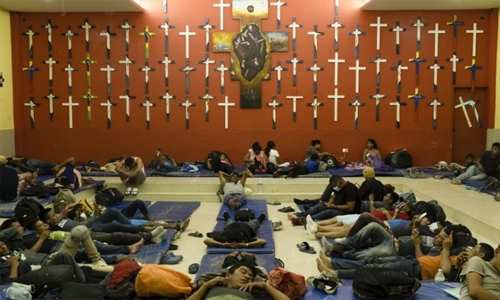Migrants on the move again in Mexico and Central America
Agencies | Tenosique
The Daily Tribune – www.newsofbahrain.com
In the first Mexican shelter reached by migrants after trekking through the Guatemalan jungle, some 150 migrants are sleeping in its dormitories and another 150 lie on thin mattresses spread across the floor of its chapel.
Only six weeks into the year, the shelter known as “The 72” has hosted nearly 1,500 migrants, compared to 3,000 all of last year. It has halved its dormitory space due to the pandemic. That wasn’t a problem last year because few migrants arrived, but this year it’s been overwhelmed, The Associated Press (AP) reported.
Latin America’s migrants — from the Caribbean, South America and Central America — are on the move again. After a year of pandemic-induced paralysis, those in daily contact with migrants believe the flow north could return to the high levels seen in late 2018 and early 2019. The difference is that it would happen during a pandemic.
The protective health measures imposed to slow the spread of COVID-19, including drastically reduced bedspace at shelters along the route, mean fewer safe spaces for migrants in transit.
“The flow is increasing and the problem is there’s less capacity than before to meet their needs” because of the pandemic, said Sergio Martin, head of the nongovernment aid group Doctors Without Borders in Mexico.
Some shelters remain closed by local health authorities and almost all have had to reduce the number of migrants they can assist. Applications for visas, asylum or any other official paperwork are delayed by the government’s reduced capacity due to the pandemic to process them.
Some migrants have expressed hope of a friendlier reception from the new U.S. administration or started moving when some borders were reopened. Others are being driven by two major hurricanes that ravaged Central America in November and desperation deepened by the economic impact of the pandemic.
President Joe Biden’s administration has taken steps toward rolling back some of the harshest policies of ex-President Donald Trump, but a policy remains allowing U.S. border officials to immediately send back almost anyone due to the pandemic. The U.S. government is concerned that the more hopeful message could set off a rush for the border and says it will take time to implement new policies.
The number of people apprehended at the U.S.-Mexico border in January was more than double that of the same month last year and 20,000 above January 2019. This week families have been seen crossing from Ciudad Juarez and turning themselves over to Border Patrol in hopes to applying for asylum.
Last week, the Biden administration announced that it would slowly start processing the approximately 25,000 asylum seekers who were forced to wait out their process in Mexico under Trump. That was scheduled to begin Friday at three border crossings.
Mexico has so far said it will continue enforcing an “orderly” migration, which in practice has meant trying to contain migrants in the south since Trump threatened tariffs on all Mexican imports in 2019.
On Tuesday, Mexico’s National Immigration Institute said in a statement that authorities had made 50 raids on freight train lines since January 25 in southern and central Mexico, detaining nearly 1,200 migrants.
President Andrés Manuel López Obrador warned migrants recently to not be fooled by traffickers who promise that the U.S. will open its doors.
In Tapachula, the largest Mexican city near its border with Guatemala and home to Mexico’s biggest detention center, there are signs of the increase as well. “There are more people applying for refuge and the increase in migrants is evident in the city’s public spaces,” said Enrique Vidal Olascoaga, lawyer for the nongovernmental organization Fray Matías de Córdova, which helps migrants with legal procedures.
Now, more than 1,300 miles to the southeast, some 1,500 migrants spread across various camps in Panama have their sights set on getting to Tapachula, either as a temporary stopover en route to the U.S. border or to begin the asylum process in Mexico.
Panama reopened its border in late January and ever since, groups have been walking out of the dense Darien jungle that divides Panama and Colombia. The government has been shuttling them to other camps closer to the Costa Rica border to make space for new arrivals.
Last week, Guatemalan immigration officials warned that a new migrant caravan could be forming in coming days in Honduras. In January, Guatemalan authorities blocked the year’s first caravan, sending nearly 5,000 Hondurans back to their country over a 10-day span.
But while Guatemala was focused on the caravan, other migrants were moving north as always in small, discreet groups. It was during the caravan last month that shelters in southern Mexico began seeing their numbers increase with mostly Honduran migrants.
Small groups of migrants are more vulnerable to criminals who kidnap and extort them, said the activist Figueroa.
Most invisible are those paying smugglers who stuff them into trailers like the one that Mexican authorities stopped in Veracruz this week. Inside were 233 migrants, mostly from Guatemala.
In late January, 19 bodies, shot and burned, were found inside a pickup truck near the Mexico-Texas border. Most were believed to be Guatemalan migrants. A dozen state police officers were arrested in connection with the case.
Related Posts

